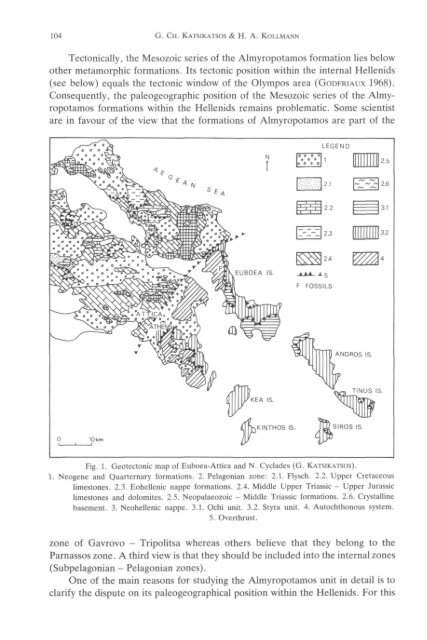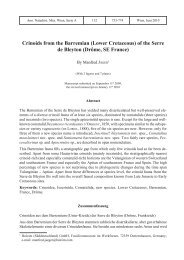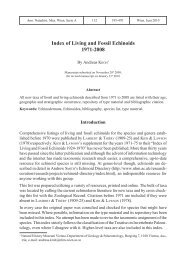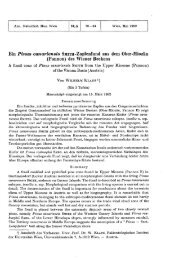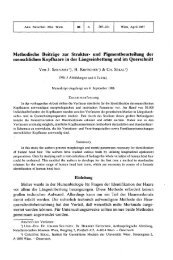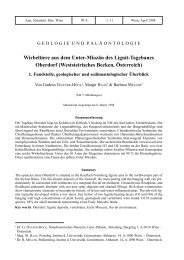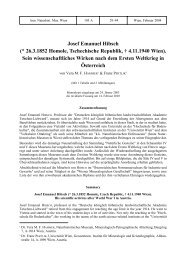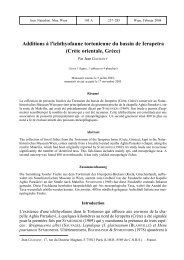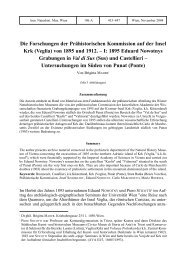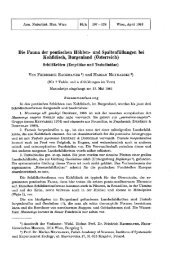An Upper Cretaceous Mollusc Fauna from the Marbles of ...
An Upper Cretaceous Mollusc Fauna from the Marbles of ...
An Upper Cretaceous Mollusc Fauna from the Marbles of ...
You also want an ePaper? Increase the reach of your titles
YUMPU automatically turns print PDFs into web optimized ePapers that Google loves.
104 G. CH. KATSIKATSOS & H. A. KOLLMANN<br />
Technically, <strong>the</strong> Mesozoic series <strong>of</strong> <strong>the</strong> Almyropotamos formation lies below<br />
o<strong>the</strong>r metamorphic formations. Its tectonic position within <strong>the</strong> internal Hellenids<br />
(see below) equals <strong>the</strong> tectonic window <strong>of</strong> <strong>the</strong> Olympos area (GODFRIAUX 1968).<br />
Consequently, <strong>the</strong> paleogeographic position <strong>of</strong> <strong>the</strong> Mesozoic series <strong>of</strong> <strong>the</strong> Almyropotamos<br />
formations within <strong>the</strong> Hellenids remains problematic. Some scientist<br />
are in favour <strong>of</strong> <strong>the</strong> view that <strong>the</strong> formations <strong>of</strong> Almyropotamos are part <strong>of</strong> <strong>the</strong><br />
10 km<br />
Fig. 1. Geotectonic map <strong>of</strong> Euboea-Attica and N. Cyclades (G. KATSIKATSOS).<br />
1. Neogene and Quarternary formations. 2. Pelagonian zone: 2.1. Flysch. 2.2. <strong>Upper</strong> <strong>Cretaceous</strong><br />
limestones. 2.3. Eohellenic nappe formations. 2.4. Middle <strong>Upper</strong> Triassic - <strong>Upper</strong> Jurassic<br />
limestones and dolomites. 2.5. Neopalaeozoic - Middle Triassic formations. 2.6. Crystalline<br />
basement. 3. Neohellenic nappe. 3.1. Qchi unit. 3.2. Styra unit. 4. Autochthonous system.<br />
5. Overthrust.<br />
zone <strong>of</strong> Gavrovo - Tripolitsa whereas o<strong>the</strong>rs believe that <strong>the</strong>y belong to <strong>the</strong><br />
Parnassos zone. A third view is that <strong>the</strong>y should be included into <strong>the</strong> internal zones<br />
(Subpelagonian - Pelagonian zones).<br />
One <strong>of</strong> <strong>the</strong> main reasons for studying <strong>the</strong> Almyropotamos unit in detail is to<br />
clarify <strong>the</strong> dispute on its paleogeographical position within <strong>the</strong> Hellenids. For this


